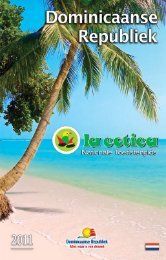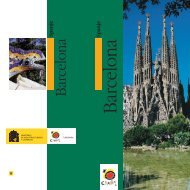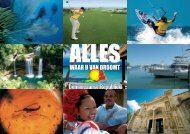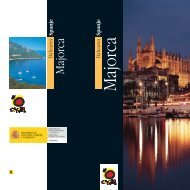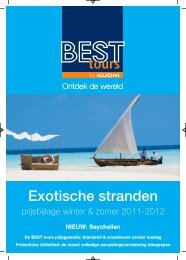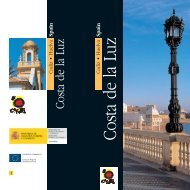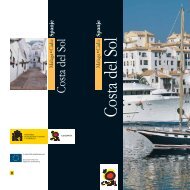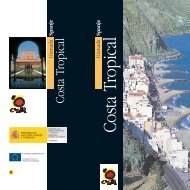Create successful ePaper yourself
Turn your PDF publications into a flip-book with our unique Google optimized e-Paper software.
GaliciaA CORUÑAGaliciathere are numerous beachesof fine white sand: PlayaAmérica, Panxón, Canido,Senil. In the interior, herds ofwild horses graze, and at thebeginning of summer, theyare brought in to be brandedand have their manes cut;this colorful rapa das bestas(wild horse roundup) usuallyGalician Granaries in Combarro ends with a romería(pilgrimage or celebration ata local shrine). The coast ofPontevedra is generally craggy, but here we can also find the Rías Baixaswith lovely peaceful beaches. Legend says these estuaries are the signleft by the fingers of God when he cleansed after creating the earth. Atthe mouth of the Ría de Vigo, we encounter the Cíes Islands (NationalPark), discovered by the Phoenicians. They were a gathering place atone time for hippies, but now the several small isles form a National Parkwith beaches of white sand that can be reached by boat from Vigo.Proceeding towards the capital Pontevedra bordering the Morrazopeninsula, there are secluded places, including the coves of Aldán,Bueu and San Simón, the extraordinary stone cross of Hio, (theloveliest in all Galicia) and closing off the estuary, the Ons Islands, Onzaand Onceta with interesting fauna, especially the cormorant.Combarro, a short distance from Pontevedra, has the bestassembly of hórreos (granaries) in Galicia, along with stonecrosses. Nearby, at the Monastery of Poio, SaintTrahamunda was laid to rest; legend says she is able to cureall types of deafness. Further north is the Monastery of AArmenteira, surrounded by legends of a monkwho spent 300 years bewitched by a bird's song.Continuing along the coast, we come to thenature reserves of A Lanzada and O Grove,famous for their beaches and waters withhealing properties. Afterwards, we find Vilanova,now connected by a bridge to Arousa Island.The next place of interest is Padrón, a townwhich received its name from the mooringstone or pedrón where the boat anchoredbearing the remains of the Apostle SaintJames (Santiago in Spanish). This was theorigin of the pilgrimages to Santiago deCompostela, a city which is now the capitalof the Galician autonomy.After skirting along the Coruña part of theestuary, we come to A Pobra do Caramiñal,the «balcony of the Arousa estuary». Along theway, we have passed Catoira, where aninteresting Viking romería takes place the firstSunday in August, while beaches of golden sandand pine trees can be seen in the background.Nearby is another nature park, the CorrubedoDunes, consisting of large expanses of sand called arenales where we findthe highest dune in the northern part of the peninsula. One of the best scenicviews can be enjoyed from the Pico Curotíña, another nature reserve.At the end of the estuary which bears its name, after passing through thecharming town of Porto do Son, is Noia. Legends tell that it is one ofthe three cities founded in <strong>Spain</strong> by Tubal, grandson of Noah (the othersare Noega in Asturias and Noja in Cantabria). Its cemetery with Medievaltombstones merits a visit. Scattered on a hill, we encounter the town ofMuros, which preserves an impressive figure of Christ salvaged from ashipwreck.Cathedral in Santiago de CompostelaEnclosed Glass Balconiesin A CoruñaMilladoiro Cross in Noia89



